Listen to Sabrina Tarasoff reading her text for the X-TRA Online series
Writers Read here.
Tell him I was too fucking busy—or vice versa.
–Dorothy Parker
What a drag. Grey skies outside, I have absconded off to bed as a modern Madame Bovary to consider its blank comfort a flighty site for all manners of horniness, ornery moods, and listless pastimes. This four-poster is a place to be unruly about work and sleep—a dreamy rock-bottom where you can idle in insomnia’s slow burn while waiting for the Ambien to inspire. (Just don’t text anyone.) Guided by the pleasure principle, I have been writing here to see where such minor social misdemeanors will get me. It is an étude for expiation: I am feeling dazzled by the possibility of amending, through a soft excision from the public domain, the dispiriting effects of the art world. Alas. It is a drag, much like mechanical house-styles, the panicky “need for explanation” (trust the Germans to have a sesquipedalian word for it: Kommentarbeduerftigkeit) not to mention the profane ridiculousness of curators wrapped up in a Lewis Carrollian caucus race. (Someone funnier than me should come up with a solid joke about how many curators it takes to put together a solo show.) Other things that “drag” linger on my mind, like trying to become “actualized” as a “person” (and “seriously, who the fuck feels like a person?” as my pal Max Grau wrote in a newsletter1), being stumped, seeing your certainty fall apart, and catching a glimpse of your life from an unflattering angle. Au même temps, the quotidian drag appears to consist of what demands attention—personal states of disassembly, the occasional contretemps, “social practices,” as they say—and so imply an open invitation to question art’s protracted boredom, its dead-ends. Being in bed is about an unknown future; I’m projecting.
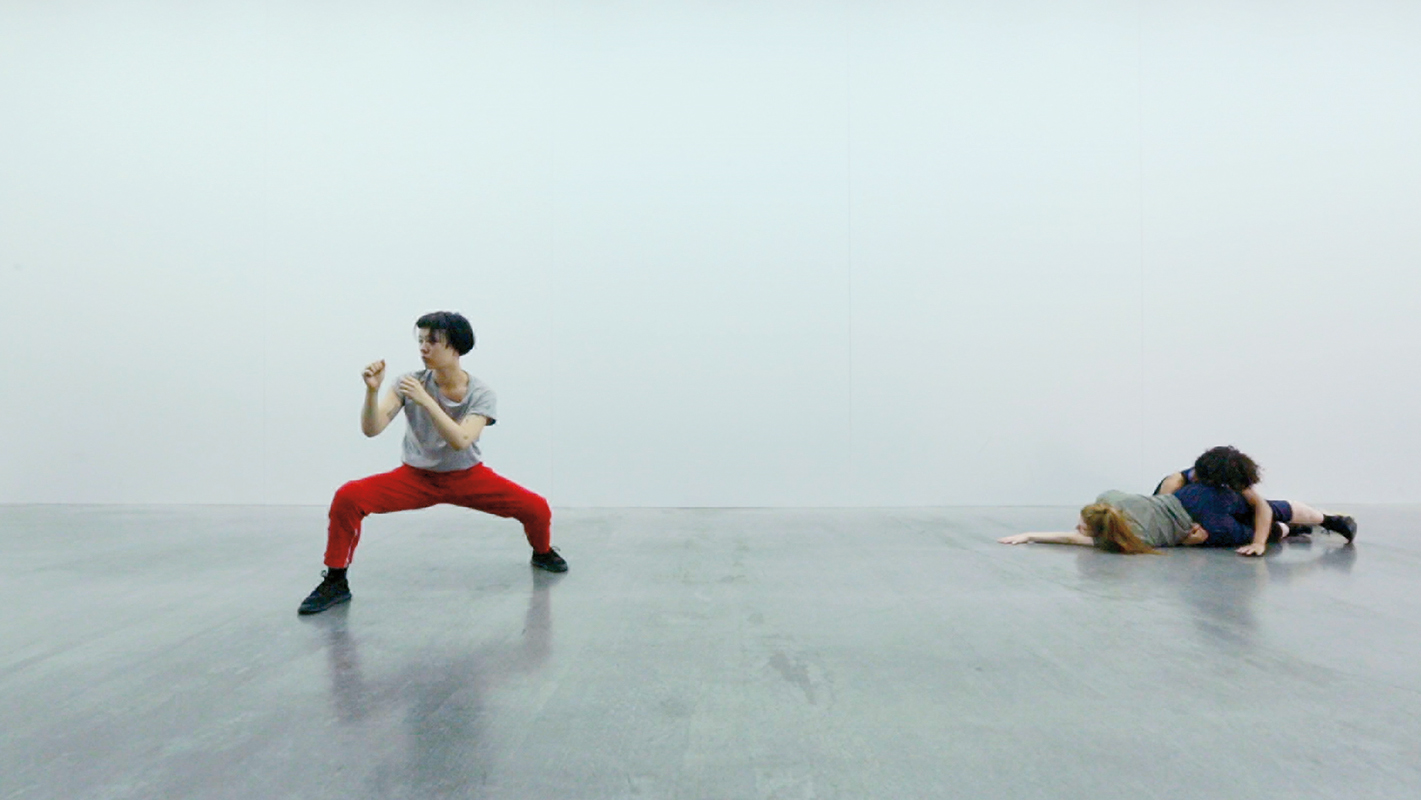
Cally Spooner, DRAG DRAG SOLO, 2016. Video still. Single channel projection on suspended transparent room dividing screen, without sound, 11:20 min. Courtesy of the artist, gb agency, Paris, ZERO…, Milan. Photo: Mathilda Olmi.
Cally Spooner’s largest show so far, referred to in the press release as “somewhere between a retrospective and a rehearsal,” DRAG DRAG SOLO was not about staying in bed, though the eponymous piece that holds the center of the Geneva show originated on a day when a dancer, taking part in Spooner’s New Museum performance On False Tears and Outsourcing (2015), should have been in bed. On a proverbial nine-to-five rehearsal schedule, the dancer showed up with a head cold and all the aching austerity that goes with it. Filmed, this choreographic fragment reads like a listless drag of the performance it wants to participate in. It’s a solemn, stand-alone piece in the Geneva show—a single-channel projected centerpiece that heralds a slow-release reversal of language’s dead codes. As much conviction as the dancer holds through her act, her body is also clearly staging a mutiny against its owner. The film catches her in the act of breaking down, dancing on a NyQuil high, and passes on a second-hand buzz through the screen. (She is ailing as elegantly as Liz Taylor post-surgery.) She should have called in sick, yet the siren call of productivity, that shiny American pragmatism, pulled her out of bed. (A new hope arises from the possibility of introducing one’s sick states into the fabric of “productivity” and so infecting it.) No doubt, Spooner was allured by the dancer’s ability to embrace a blighted body, ignoring all of its conventions of charm, composure, and precision. She understood the charm of being absolutely charmless; the poetics of the sick drag. This excision from the larger fabric of False Tears and Outsourcing became the indisposed mood-maker of Spooner’s Geneva takeover: a pared-down, liminal experience, a way of thinking about being in a body or mind that refuses to cooperate.
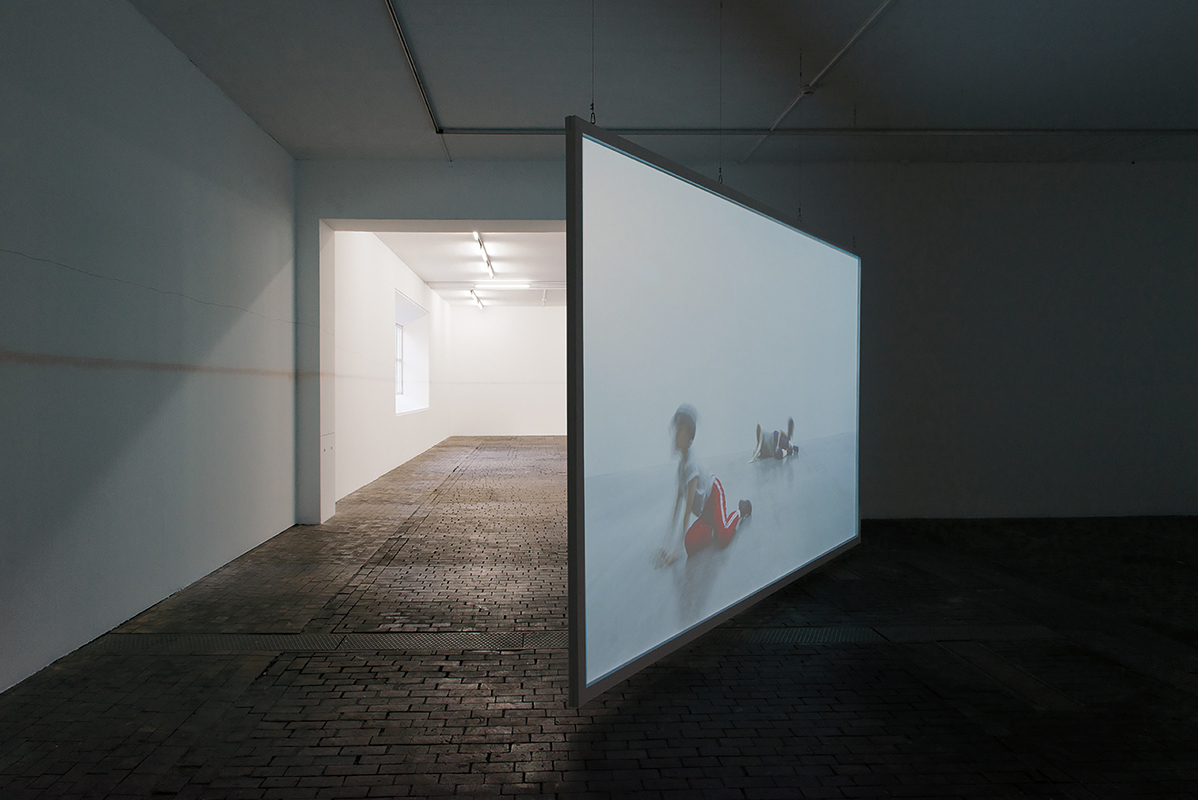
Cally Spooner, DRAG DRAG SOLO, 2016. Video still. Single channel projection on suspended transparent room dividing screen, without sound, 11:20 min. Installation view, DRAG DRAG SOLO, Centre d’Art Contemporain Genève, Switzerland, February 3-March 18, 2018. Courtesy of the artist, gb agency, Paris, ZERO…, Milan. Photo: Mathildi Olmi.
This is where Spooner’s performances draw me, or maybe drag me, into a complex about liveness. By liveness, I am melodramatically thinking about being alive, i.e., not dead or inanimate, but existentially about being level, alive at a specifically fucked-up time, about failing to live up to the expectations of neoliberalism’s ride or die, while living out—what? precariousness, delusions, dreamy rites of penmanship?—and doing so live, in the flesh, personally, not only on record, or perhaps not on record at all. Spooner speaks to this liveness because her work paradoxically examines the deadened aspects of our daily lives: places where extemporaneity, precariousness, fuck-ups, and forays have been edited out and where, in her own words, “live thought is caught transforming into cliché.”2 To find these dead zones, just consider her work’s past transfixions, for example, how we become bewitched by industrially produced pop music—the kind that has been designed to arouse increasingly specific states of being. (Think Low-Key Fairy Godmother of Pop Robyn, whose 2010 track, “Dancing on My Own,” nailed MDMA’s dance floor disco-sadness.3) Spooner points to those moments in the mainstream when public audiences turn poisonous realizing that the faces they idolize are faking it, as well as those semi-literary situations (like pretending you’re some Flaubertian heroine, online shopping in bed; writing in Jane Bowlesey distress; or collapsing into acerbic wit à la Dorothy Parker) when our emotional-carrying capacities are overwhelmed and we start seeking outside solutions. To think about this differently, Spooner’s art is an exaltation of what some genius critic coined “the bathos of impact,” in reference to MTV’s Jackass series.4Only here the letdown is social, cultural, emotional. Liveness—or being alive (staying alive), or at least feeling alive—happens when our trite routines and acquired behaviors crumble, which, on Spooner’s terms, is when ill-fitting communicative acts clash and the belief systems ascribed to them are seen “slouching towards” disillusionment.5 (Like Eve Babitz, I would here also like to “thank the Didion-Dunnes for having to be what I am not.”6) What her work pushes is the emotional whiplash experienced by an unsuspecting public as they find themselves comfortably dead under the good grace of capital’s performatives, only to be rudely awakened by hiccups and glitches in the system—hiccups that are a total drag yet end up affirming one’s onerous existence.
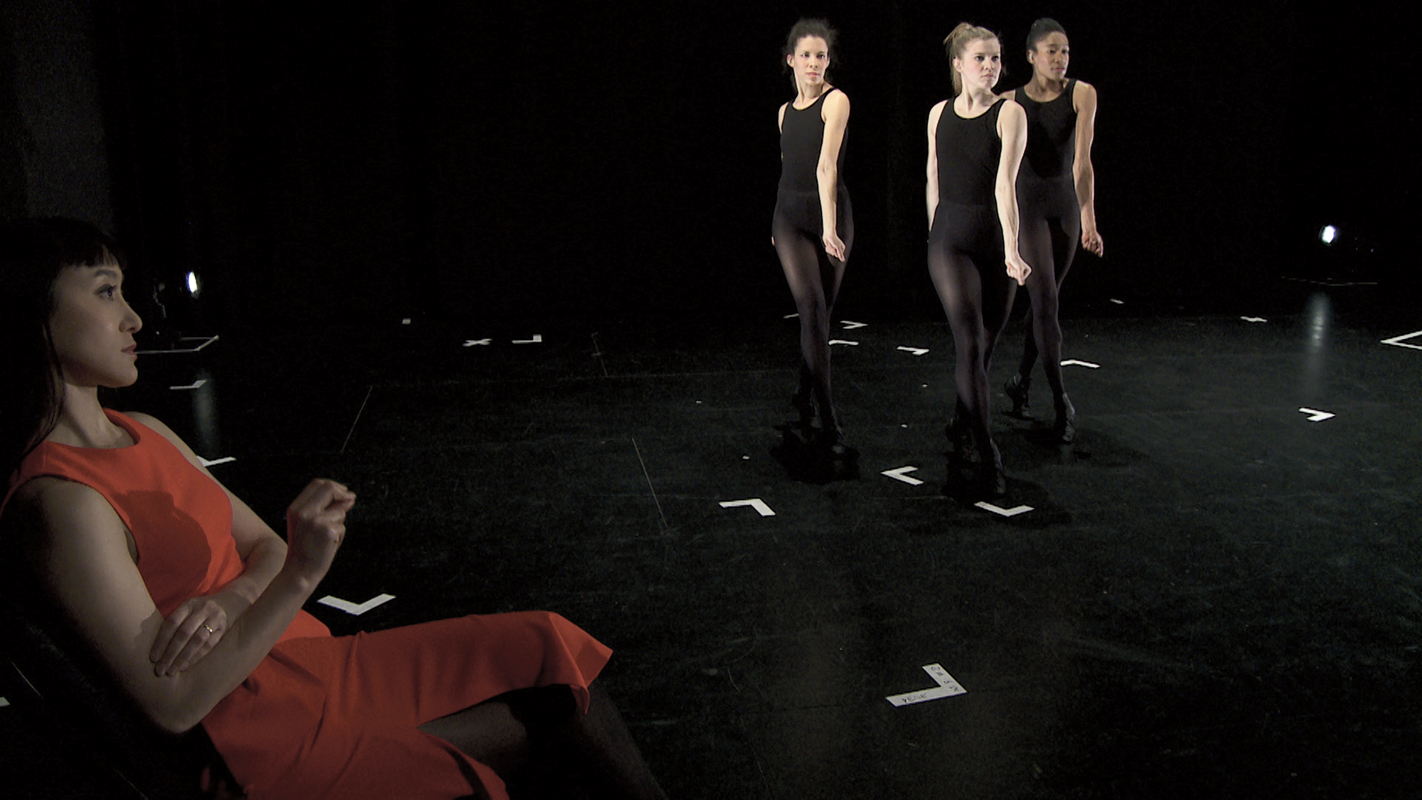
Cally Spooner, And You Were Wonderful, On Stage, 2013–15. Film still. 5 Channel HD Installation, 45 min. Courtesy the artist, gb agency, Paris, and ZERO…, Milano and EMPAC, The Curtis R. Priem Experimental Media and Performing Arts Center, Troy, NY.
It is too dizzying to think about precisely how dead I am in my daily rites of absent-minded Instagramming and love of Lifetime films, how many traps of language I live in, or how outsourced my emotions have become. (And where do they go in this psychological cost-saving strategy?!) Though I believe that personal unruliness will raise me from whatever kind of dead that ends up being and that I can “exorcise my rites” (as the tagline for teen-horror masterpiece The Craft [1996] goes) by siding with senses of the recalcitrant, sulking, exacting, amped-up, babyish, and pleasantly bored, Spooner assumes the maelstrom mess is productive in and of itself. A few weeks ago, she wrote to me via email on a rambling tack—she’s not exactly the cool customer, Joan Didion-type of writer—about the amateurism of the unforeseen as an opposition to professionalization. She writes: “I’m converted! Into the ambiguous, suspended between things, nascent and immature. The new ‘not yet arrived.’… Precariousness as a type of freedom. Moving and traversing between uncertain possibilities could be political plasticity. Shuffling and meshing separate parts renews form. There must be many ways through things maintained (especially against the looming prospect of monolithic net giants controlling who can go where at a potential price) unexpected, expanding diversions—we need them!”7
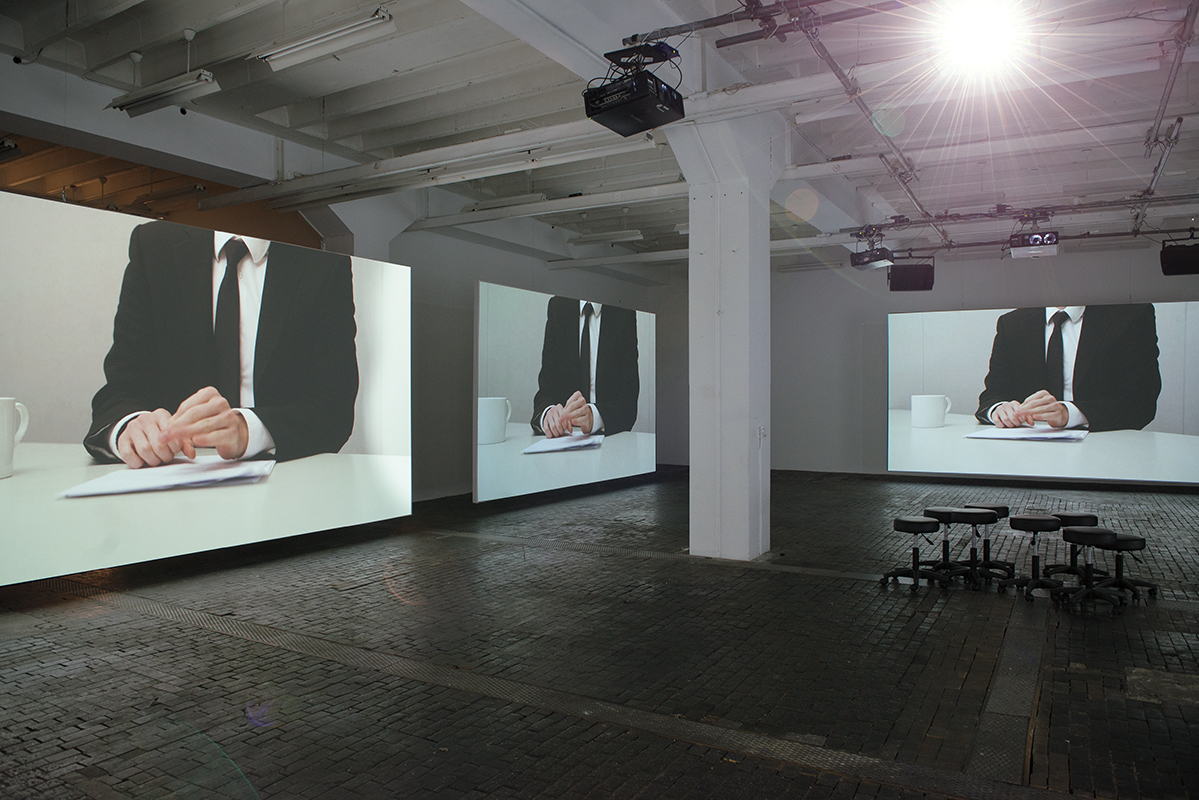
Cally Spooner, And You Were Wonderful, On Stage, 2013–15. 5 Channel HD Installation, flat screen, vinyl wall text, 45 min. Installation view, DRAG DRAG SOLO, Centre d’Art Contemporain Genève, Switzerland. Photo: Mathilda Olmi.
DRAG DRAG SOLO’s constellation of featherweight events unfolded across the Centre d’Art Contemporain’s three levels. I spent a weekend wandering around. I was profoundly jet-lagged and thus drawn to the space’s more bed-like qualities—a soft and quiet site for idle fantasy, though also for elated late-night banter, heavy hangovers, and some time left over to read and eat pizza. (In any case, that is how it went down.) In ascending chronological order, DRAG DRAG SOLO presented Spooner’s “bygone,” “present,” and “future,” through which the viewer walked to encounter a gradually diminishing body of work. Like the fantastical five-channel chorus-line of And You Were Wonderful, On Stage (2013–15) on the first floor, many of the works felt barely there. On the second floor, you encountered amongst other things an incongruous alarm clock hidden in plain view and a nondescript performer crumbling a bar of soap—a soupçon of surrealism that teased out the feeling of dreams, with their strange details and non-sequiturs. DRAG DRAG here becomes a double-pun: drag, as in being a lump ticking towards movement by a tech-elusive force—for example, time, and drag as a form of extremely self-conscious performance. (The alarm, to my knowledge, never went off.) This reliance on ready-mades and scant gestures would risk tumbling into the territory of things that “need explanation” if it did not string together its singularities as a sequence of mystifying events. (Somewhere in here is an allusive connection to Lewis Carroll’s Alice’s Adventures in Wonderland, with the March Hare’s clock decked out with custom soundscapes and the Mad Hatter a soapy James Dean-esque Italian screaming things such as, “To a comfier place in the pillow!”) The pushy may have demanded explanations as to how the clock “outsources” or “externalizes” our circadian rhythms, or why install a radio on a wall, emitting a barely audible hum? But to freak out about the show’s theoretical apparatus is to miss its existential bent. As Spooner wrote to me in an email shortly before the show: “[I] find that living work could be de ned by being largely undersigned; allowed to land where it lands, in the margins of last-minuteness to rise, fall, then start again, not necessarily and not forever, picking up again as an amateur.”8
To fully comprehend amateurism’s difficult liveness, turn the page to an epistolary exchange between Albert Camus and Francis Ponge, which was penned sometime after the former finished the first manuscript for The Myth of Sisyphus (1942). “Another thing I did not tell you,” Ponge writes to Camus in a letter, “Personally, the heaviness of my rock often discourages me and makes me very lazy. Can we imagine a lazy Sisyphus?”9 Ponge’s prose-poem Soap (1943–65) (which may be an essay, as in the French essai, for attempt), gets all the airtime as the underlying reference in the soap-crumbling act of By all accounts he was a very ordinary man… (2018). But the deeper idea may be a similar acknowledgement of exertion’s crumbling effect. As a neurotic gesture, breaking apart the soap bar mirrors Ponge’s idle discountenance from his task. It’s unclear as to what the “point” of the performance is; this lack of clarity is reflected in the actor’s countenance. Like imagining a slacker Sisyphus dragging his rock, only to decide nahhhh, Spooner’s set-up ends in foundering and thus failure. With the occasional Tourette-esque yowl, the performer leaves in his wake a soap-sudded trail of language’s insufficiency—a recalcitrant variation on what Judith Butler termed “poetics of non-arrival,” in relation to Franz Kafka.”10 Certainly, Ponge pushed ahead in his writing and also pushed his position as a writer outside of the life-giving gazes of academia, the salon, and their established languages. His crisis of speech was inseparable from a crisis of productivity: how to produce, and how to speak for mutable, unfinished objects?
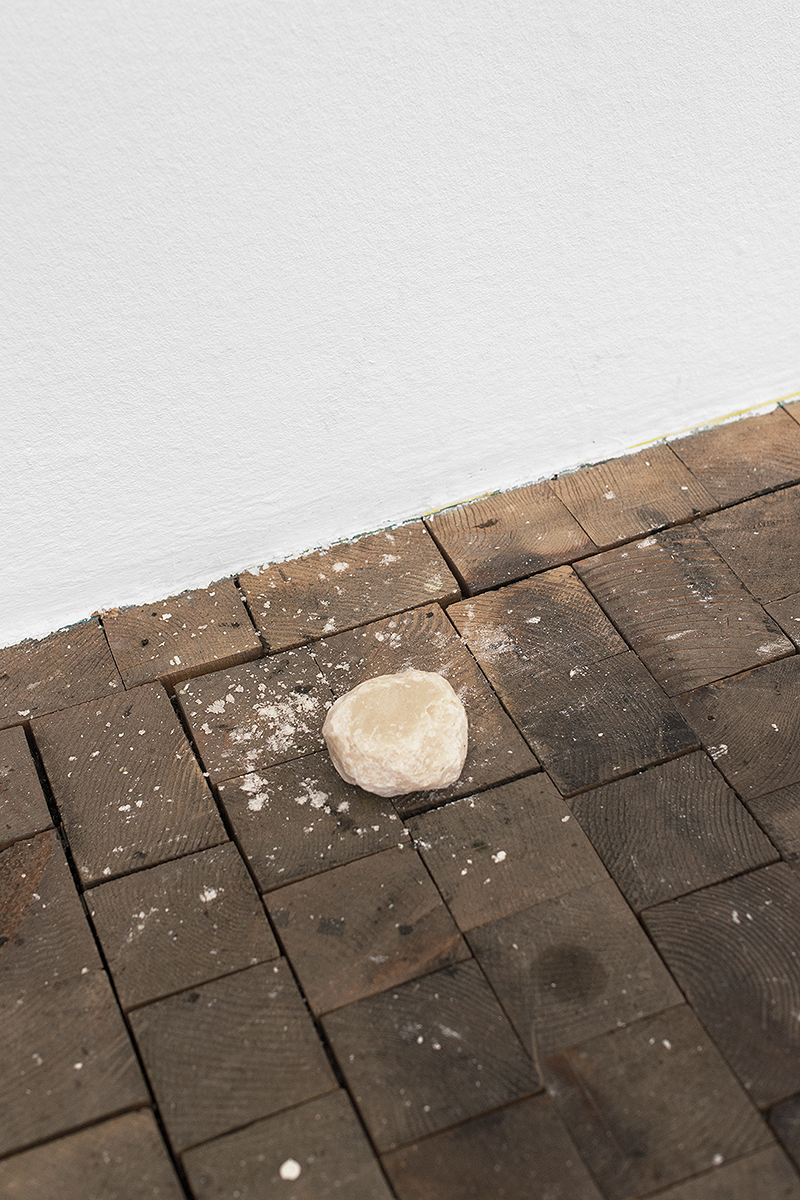
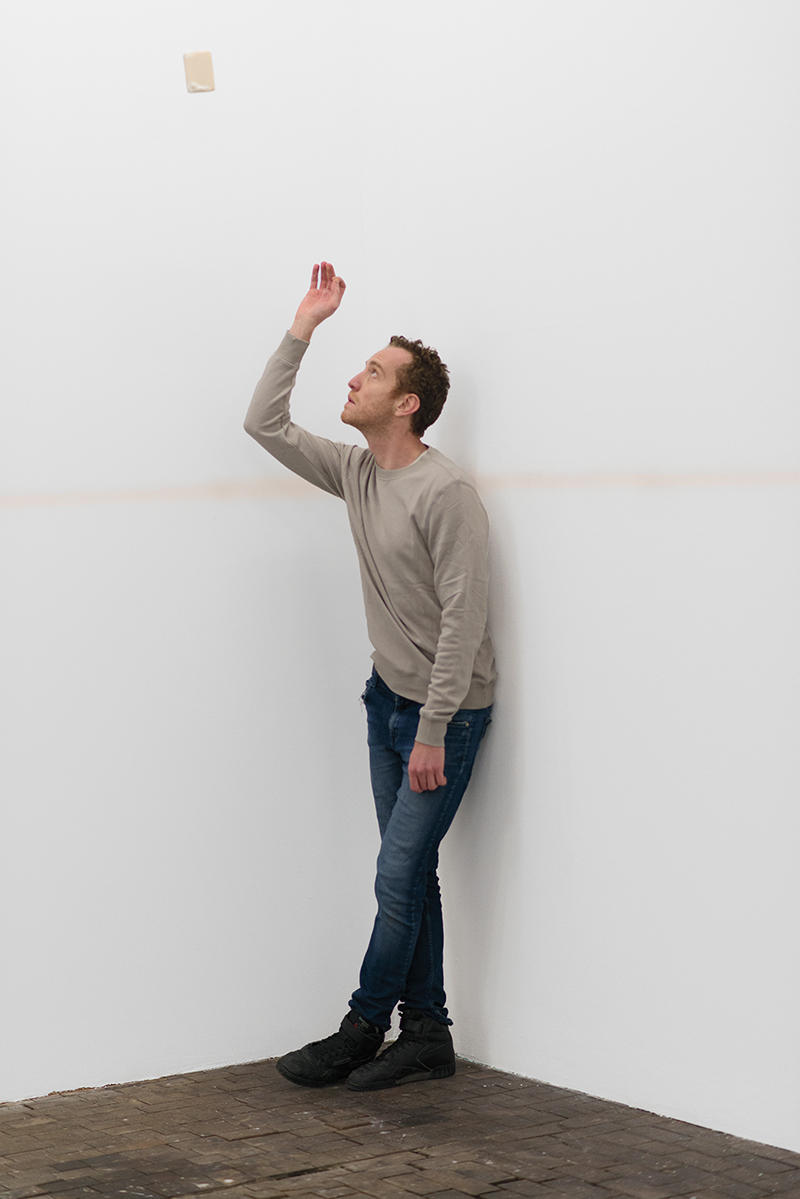
Above and top: Cally Spooner, By all accounts this was a very ordinary man, 2018. Orator, language, soap. Detail and performance view with Michelangelo Miccolis, DRAG DRAG SOLO, Centre d’Art Contemporain Genève, Switzerland. Courtesy of the artist, gb agency, Paris, ZERO…, Milan. Photos: Mathilda Olmi.
I have said this elsewhere, and I apologize, but as the tagline for the film Pet Sematary (1989) goes, “Sometimes dead is better.” Ponge proceeds to discuss soap as an exhausted subject that tells about itself in the very act of its destruction just as much as the actor’s silent expatiation in By all accounts he was a very ordinary man proved his character’s slow-release “life” as an exercise in some John Keatsian negative capability—a capacity to dwell in diminution and exhaustion and to think productively through one’s turgid moods. As the work’s caption implies, the actor is an unfinished “character” from Spooner’s future novel; he is a thought put out there into the public for scrutiny, consideration, and development (kind of like Philippe Parreno and Pierre Huyghe’s tabula rasa conundrum Annlee, of No Ghost Just a Shell, initiated in 1999). Perhaps this relates to monumentality (like a body in bed, weighing down sheets). But how to drag meaning from that?
Still in bed, and as a dead-tired subject myself, I am slowly coming to the realization that not getting started with my day is the very proof of my liveness. Tired, achy, uninspired, what a comfort to think about Spooner’s exhibition as driven by the performative possibilities of being in a lather. On the final (third) floor, discover a dancer stretching over and over again. Hers is the most shiftless Sisyphean task: no performance ever comes to fruition. Instead, she becomes lost in a sea of gallery-goers more concerned with cocktails and small talk than consideration what a big feat her small moves are. Though the performances only happened at intervals through the span of the exhibition, alleviating the two performers from over-exertion and reducing the risk that they die of boredom, both were required to be on site for hours on end. Maybe this speaks to a certain kind of labor capital, though I’ll leave that for theorists to confabulate on. That everything feels unfinished, tense under the weight of waiting, and so close to not being there at all, is a thought to easily rest on. Everything lands where it lands, be it from the artist’s personal weariness, her desire to slow things down (in her own practice and the haste imposed on it by the art world’s rampant pace) or from the conceptually more eager positions of working with casts of people who can throw prescribed ideas out of focus, operating against the dead ends of art’s bio-capital subscriptions and their sneaky way into our communicative systems. “A lot of things that are definitely not considered live,” Spooner wrote to me, “can be more alive than anything that is (in theory) living, just as a lot of fiction is more true than our facts.”11 Being in bed is a libertine pleasure because nothing has to be real in here; getting up is still an unknown future, one not yet realized—and yet everything feels like it can be, and on your own terms. In this sense, Spooner’s work begins to advocate staying in a space of the imaginary—if only to drag out the inevitable. I was told that the work feels indulgent at this very urgent moment in time, but I disagree. Why does the political have to hinge on “urgency”? Surely any type of change (emotional, political) is a slow show of exhaustion, a discouraged Sisyphean action that ultimately finds its form.
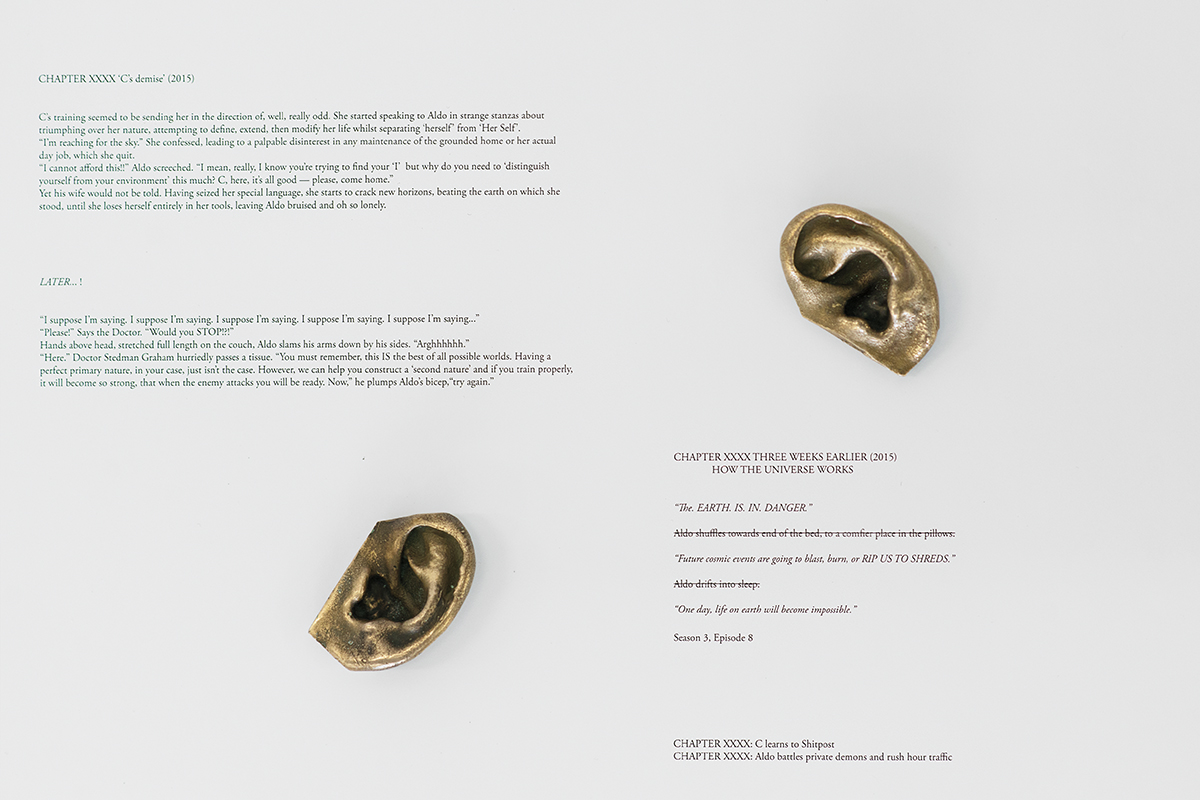
Cally Spooner, Early Research: Method #5 (detail), 2016. Bronze cast of the artist’s ear, fiction, paper, offset print. Courtesy of Collection Nathalie Mamane-Cohen. Photo: Mathilda Olmi.
For the sake of satisfying those craving for some crunchy Kommen-tarbeduerftigkeit: Rewind to 2017. Spooner and I are on Skype (from bed, coincidentally, I swear) speaking of her recent move to Athens, Greece, about slowing down the pace of the art world, needing a break, and the importance of taking vacations even if the thought itself is stressful for fear of having “nothing to do.” At the time, she was guiding a workshop at Goldsmiths, University of London, in the wake of the suicide of cultural theorist and blogger Mark Fisher, aka “k-punk.” Fisher’s former students constituted a part of the cohort. Spooner and I spoke about their stirred-up zeal for immediate action, which involved grandiose hopes that letters of protest and an organized student body would push Goldsmiths into renewing their mental health care policies. The emphasis of the dialogue was organization: the arrangement of bodies, the assigning of roles, and a process of decision-making about where, when, and how they would assemble to continue their political organization. It became cyclical, a dire classroom caucus that resulted in the exasperation of not being heard, not reaching the right parties, and these lofty goals not coming to fruition by the simple recognition of how important, how urgent the cause was—that is, how fucking painful. Our societal need for immediate gratification notwithstanding, I think the failures of this approach lay in a seemingly unrealistic lack of patience married to the even more unrealistic belief that the hysterical voicing of the lack of appropriate psychiatric support for faculty and students alike would touch a godlike nerve capable of overthrowing bureaucracy’s slow show. (From my personal experiences as a student at California Institute of the Arts, the bureaucrats simply don’t care.) My conversation with Spooner hovered around a felt lack of embrace of certain forms of door-to-door politics, like calling your Congress member; organizing lengthy, hand-signed petitions; and literally going out into communities to speak to your constituency. But let’s be honest—knocking on doors is not even remotely as exciting as the prospect of an uprising. In so many words, what a drag.
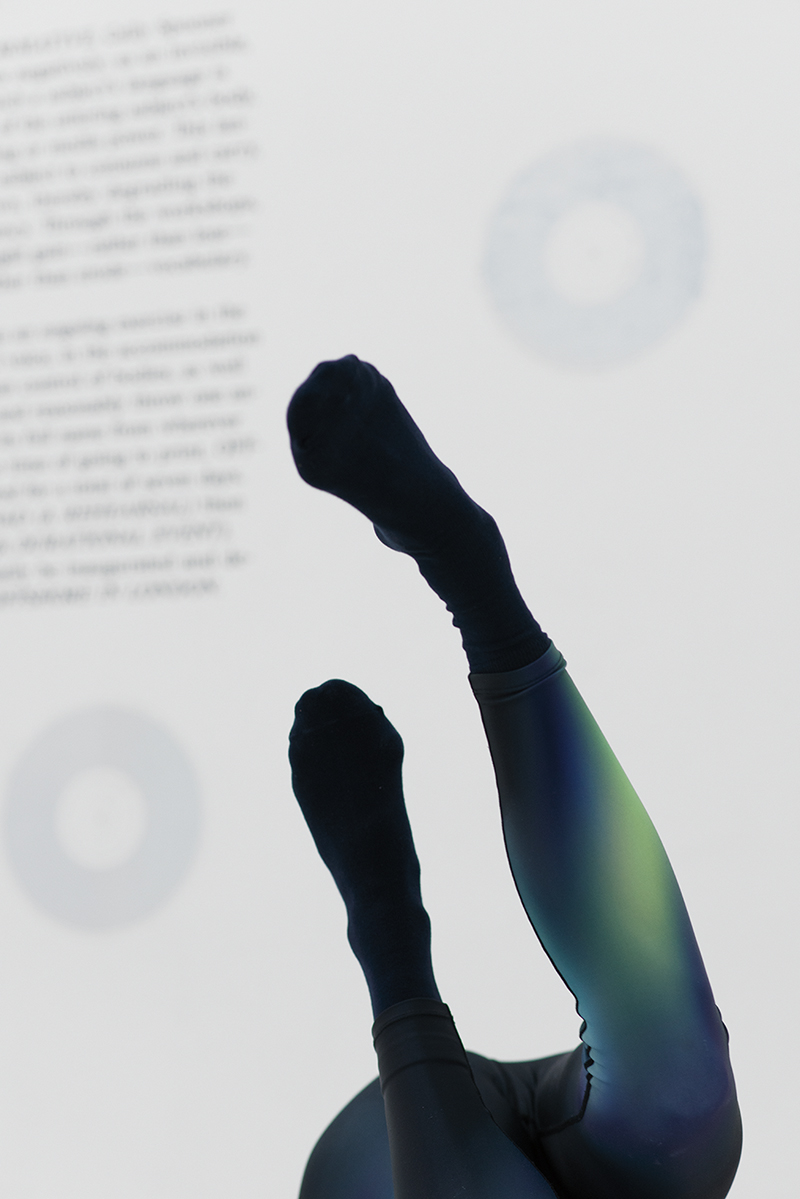
Cally Spooner, Warm-up, 2016. Dina Khuseyn performing on the occasion of DRAG DRAG SOLO, Centre d’Art Contemporain Genève, Switzerland. Photo: Mathilda Olmi.
It’s 2:00 p.m., and I’m in deep sheet with this deadline, wishing writing could be all semaphores and silence. Bed may not be a proactive approach to institutional nausea, bureaucratic overhaul, and value amassed in the abstract, i.e. the art world’s fucked-up-ness, but it is a way to momentarily look at such anxieties as outside of myself, like blithely prodding the mal d’institution de l’art as an object. Secretly, I’ve been patting myself on the back for having created such a dazzling critical carapace out of my bed linens. Yet thinking back to this anecdote, my shell may have cracked. Perhaps I’m dissociating. Dissociating—! Turns out this critical impenetrability may just be a side effect of mental illness; maybe I’m externalizing what confounds the most.
I often do feel shell-shocked.
Sabrina Tarasoff is a Finnish writer based in Los Angeles.
